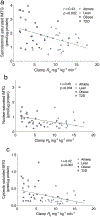Subcellular localisation and composition of intramuscular triacylglycerol influence insulin sensitivity in humans
- PMID: 33128577
- PMCID: PMC7718332
- DOI: 10.1007/s00125-020-05315-0
Subcellular localisation and composition of intramuscular triacylglycerol influence insulin sensitivity in humans
Abstract
Aims/hypothesis: Subcellular localisation is an important factor in the known impact of bioactive lipids, such as diacylglycerol and sphingolipids, on insulin sensitivity in skeletal muscle; yet, the role of localised intramuscular triacylglycerol (IMTG) is yet to be described. Excess accumulation of IMTG in skeletal muscle is associated with insulin resistance, and we hypothesised that differences in subcellular localisation and composition of IMTG would relate to metabolic health status in humans.
Methods: We evaluated subcellular localisation of IMTG in lean participants, endurance-trained athletes, individuals with obesity and individuals with type 2 diabetes using LC-MS/MS of fractionated muscle biopsies and insulin clamps.
Results: Insulin sensitivity was significantly different between each group (athletes>lean>obese>type 2 diabetes; p < 0.001). Sarcolemmal IMTG was significantly greater in individuals with obesity and type 2 diabetes compared with lean control participants and athletes, but individuals with type 2 diabetes were the only group with significantly increased saturated IMTG. Sarcolemmal IMTG was inversely related to insulin sensitivity. Nuclear IMTG was significantly greater in individuals with type 2 diabetes compared with lean control participants and athletes, and total and saturated IMTG localised in the nucleus had a significant inverse relationship with insulin sensitivity. Total cytosolic IMTG was not different between groups, but saturated cytosolic IMTG species were significantly increased in individuals with type 2 diabetes compared with all other groups. There were no significant differences between groups for IMTG concentration in the mitochondria/endoplasmic reticulum.
Conclusions/interpretation: These data reveal previously unknown differences in subcellular IMTG localisation based on metabolic health status and indicate the influence of sarcolemmal and nuclear IMTG on insulin sensitivity. Additionally, these studies suggest saturated IMTG may be uniquely deleterious for muscle insulin sensitivity. Graphical abstract.
Keywords: Athlete’s paradox; Diabetes; Insulin sensitivity; Intramuscular triacylglycerol; Lipid composition; Skeletal muscle.
Figures





Similar articles
-
Intracellular localization of diacylglycerols and sphingolipids influences insulin sensitivity and mitochondrial function in human skeletal muscle.JCI Insight. 2018 Feb 8;3(3):e96805. doi: 10.1172/jci.insight.96805. eCollection 2018 Feb 8. JCI Insight. 2018. PMID: 29415895 Free PMC article. Clinical Trial.
-
Intramuscular triglyceride synthesis: importance in muscle lipid partitioning in humans.Am J Physiol Endocrinol Metab. 2018 Feb 1;314(2):E152-E164. doi: 10.1152/ajpendo.00142.2017. Epub 2017 Oct 3. Am J Physiol Endocrinol Metab. 2018. PMID: 28978544 Free PMC article.
-
Increased intramuscular lipid synthesis and low saturation relate to insulin sensitivity in endurance-trained athletes.J Appl Physiol (1985). 2010 May;108(5):1134-41. doi: 10.1152/japplphysiol.00684.2009. Epub 2010 Mar 18. J Appl Physiol (1985). 2010. PMID: 20299618 Free PMC article.
-
Increased intramuscular lipid storage in the insulin-resistant and endurance-trained state.Pflugers Arch. 2006 Feb;451(5):606-16. doi: 10.1007/s00424-005-1509-0. Epub 2005 Sep 10. Pflugers Arch. 2006. PMID: 16155759 Review.
-
High intramuscular triglyceride turnover rates and the link to insulin sensitivity: influence of obesity, type 2 diabetes and physical activity.Appl Physiol Nutr Metab. 2022 Apr;47(4):343-356. doi: 10.1139/apnm-2021-0631. Epub 2022 Jan 21. Appl Physiol Nutr Metab. 2022. PMID: 35061523 Review.
Cited by
-
Sex Differences in Insulin Sensitivity are Related to Muscle Tissue Acylcarnitine But Not Subcellular Lipid Distribution.Obesity (Silver Spring). 2021 Mar;29(3):550-561. doi: 10.1002/oby.23106. Obesity (Silver Spring). 2021. PMID: 33624435 Free PMC article.
-
Obesity-Related Insulin Resistance: The Central Role of Adipose Tissue Dysfunction.Handb Exp Pharmacol. 2022;274:145-164. doi: 10.1007/164_2021_573. Handb Exp Pharmacol. 2022. PMID: 35192055
-
Possible Mechanisms Linking Obesity, Steroidogenesis, and Skeletal Muscle Dysfunction.Life (Basel). 2023 Jun 19;13(6):1415. doi: 10.3390/life13061415. Life (Basel). 2023. PMID: 37374197 Free PMC article. Review.
-
Role of gender in explaining metabolic syndrome risk factors in an Iranian rural population using structural equation modelling.Sci Rep. 2023 Sep 25;13(1):16007. doi: 10.1038/s41598-023-40485-y. Sci Rep. 2023. PMID: 37749166 Free PMC article.
-
Recent advances in understanding the mechanisms in skeletal muscle of interaction between exercise and frontline antihyperglycemic drugs.Physiol Rep. 2024 Jun;12(11):e16093. doi: 10.14814/phy2.16093. Physiol Rep. 2024. PMID: 38845596 Free PMC article. Review.
References
-
- Pan DA, Lillioja S, Kriketos AD, et al. (1997) Skeletal muscle triglyceride levels are inversely related to insulin action. Diabetes 46: 983–988 - PubMed
-
- Krssak M, Falk Petersen K, Dresner A, et al. (1999) Intramyocellular lipid concentrations are correlated with insulin sensitivity in humans: a 1H NMR spectroscopy study. Diabetologia 42: 113–116 - PubMed
-
- Phillips DI, Caddy S, Ilic V, et al. (1996) Intramuscular triglyceride and muscle insulin sensitivity: evidence for a relationship in nondiabetic subjects. Metabolism 45: 947–950. - PubMed
-
- Perseghin G, Scifo P, De Cobelli F, et al. (1999) Intramyocellular triglyceride content is a determinant of in vivo insulin resistance in humans: a 1H-13C nuclear magnetic resonance spectroscopy assessment in offspring of type 2 diabetic parents. Diabetes 48: 1600–1606. - PubMed
-
- Goodpaster BH, He J, Watkins S, Kelley DE (2001) Skeletal muscle lipid content and insulin resistance: evidence for a paradox in endurance-trained athletes. J Clin Endocrinol Metab 86: 5755–5761 - PubMed
Publication types
MeSH terms
Substances
Grants and funding
LinkOut - more resources
Full Text Sources

